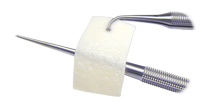A Connective Tissue Graft is a dental procedure that corrects gingival (gum) recession. When the gum tissue that surrounds the teeth pulls back, it exposes the tooth’s root, and so Gingival recession occurs as a result. This condition is often due to gum disease or over aggressive tooth brushing. Gum recession will also lead to other problems like loss of supporting bone and increased plaque build-up.
Problems With Gum Recession
Two leading reasons why gum tissue recedes and roots become exposed are due to over aggressive brushing and gum disease. Exposed roots may be sensitive due to hot and cold, vulnerable to decay, and associated with loss of supporting bone. Furthermore, gum recession and exposed roots can lead to the following problems (Figure 1):
- Decrease in esthetics
- Increase in root sensitivity
- Loss of supporting bone
- Increase in plaque build-up*
- Risk of future recession*
Correcting Gum Recession
Healthy gum tissue protects your teeth from disease and sensitivity, and as a result, is the basis of a great smile. However, when you lose gum tissue around your teeth it can be the beginning of serious oral health problems. Fortunately, Dr. Yolanda Cruz can perform a connective tissue graft so to correct this tissue loss. Usually, the doctor will harvest a piece of tissue from the roof of your mouth to consequently serve as the graft material. However, not all patients have enough tissue available. Additionally, some patients are reluctant to have tissue taken from this sensitive area. Therefore, patients can opt for an alternative solution called Alloderm. Alloderm is a graft material from donated human tissue.

WHAT IS ALLODERM?
AlloDerm is donated human tissue that has been processed to remove donor cells, leading to a regenerative tissue matrix. LifeCell Corporation processes AlloDerm and BioHorizons distributes AlloDerm to dental professionals.
HOW SAFE IS ALLODERM?
AlloDerm is widely used in both medicine and dentistry for plastic and reconstructive surgery. This graft material was first developed to treat burn patients and is now also used in:
- General surgery
- Urogenital surgery
- Orthopedic surgery
- Dental surgery
Since its introduction in 1994, over 1 million AlloDerm grafts have been successfully placed with no known incidence of disease transmission. Donor tissue is extensively screened and tested for the presence of diseases and then it undergoes LifeCell’s proprietary processing procedures to ensure that AlloDerm is virally inactivated before release for patient care.
AFTER SURGERY
After the surgery, the doctor will provide post operative instructions. Post operative instructions could include:
- Cover surgical site with a dressing material
- Antibiotics prescribed to limit inflammation
- Medication prescribed to manage post operative pain
- Mouth rinse prescribed to clean surgical site
- Avoid brushing and chewing at the surgical site
For More Information
Because every patient is different and patient results may vary, only a trained surgical dentist can determine the best treatment plan for you. Therefore, Dr. Yolanda Cruz will explain the benefits and risks and determine if AlloDerm grafting is right for you. Schedule a consult today – call us at at our Downtown office 416-595-5490 . You can also find information on the web at https://www.biohorizons.com/
References*
AlloDerm An Effective Alternative to Palatar Donor Tissue for Treatment of Gingival Recession. Allen EP Dent Today 2006; 48. 50-2; quiz 52
Histologic Evaluation of Autogenous Connective Tissue and Acellular Dermal Matrix Grafts in Humans.
Cummings LC, Kaldahl WB, Allen EP. J Periodontal 2005;76: 178-186
Clinical Evaluation of 3 Techniques to Augment Keratinized Tissue Without Root Coverage. Harris RJ J Periodontal 2001; 72: 932-938
Helpful Related Links
- American Dental Association (ADA). Glossary of Dental Terms.
- American Academy of Cosmetic Dentistry® (AACD). Home Page.
- WebMD. WebMD’s Oral Care Guide.



